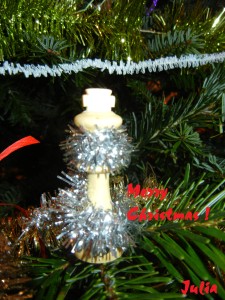| No.463 Julia Vysotska (Latvia) |
Original Problems, Julia’s Fairies – 2013 (III): September- December →Previous ; →Next ; →List 2013(III) Please send your original fairy problems to: julia@juliasfairies.com |
 No.463 by Julia Vysotska – my lovely Locust piece in the first stalemate I’ve composed, with a Merry Christmas wishes to all of you! The white King is missing there, as it is on the Christmas Tree already! I won’t take it back from there, as the problem feels quite good without it! 🙂 (JV)
No.463 by Julia Vysotska – my lovely Locust piece in the first stalemate I’ve composed, with a Merry Christmas wishes to all of you! The white King is missing there, as it is on the Christmas Tree already! I won’t take it back from there, as the problem feels quite good without it! 🙂 (JV)
Definitions:
Locust (L): moves on Q-lines but only by capturing an enemy unit, arriving on the square immediately beyond that unit, which must be vacant.
Nightrider(N): (1,2) Rider. Operates along straight lines with squares lying a Knight’s move away from each other.
Take & Make: Having captured, a unit must immediately, as part of its move, play a non-capturing move in imitation of the captured unit from the capture-square. If no such move is available, the capture is illegal. Promotion by capture occurs only when a pawn arrives on the promotion rank as the result of a take&make move. Checks are as in normal chess: after the notional capture of the checked K, the checking unit does not move away from the K’s square.
Anti Take & Make: Every capture (“take”) must be complemented by a further step (“make” which is not a capture) by the captured piece (Kings excluded), which must move from its square of vanish (according to the wishes of the capturing side in case of options). The capture is forbidden if the captured unit has no possible moves. Promotions at the end of the “make” element are normal.
|
No.463 Julia Vysotska
Latvia
original-24.12.2013
Merry Christmas to all JF visitors!
 h=2 2 solutions (1+2+1n)
Take&Make Anti-Take&Make Locust f6 Nightrider c2 (no white King) Solutions: (click to show/hide)
|



Dear Julia,
Here is a plus “little thingy” to your Christmas composition:
White Nightrider c2
Black Be8 Kc5
Neutral Locust f6
h=2 2 solutions b) Kc5→c4 (1+2+1n)
Take&Make
Ant-Take&Make
(no white King)
a) I. 1.Be8-b5 Nc2-e6 + 2.nLf6*e6-e8[+wNc2] nLe8*b5-c6[+bBc4] =
II. 1.Be8-c6 Nc2-d4 2.nLf6*d4-a4[+wNf5] nLa4*c6-b5[+bBd5] =
b) I. 1.Be8-c6 nLf6*c6-f2[+bBb5] 2.nLf2*c2-d3[+wNb4] Nb4-a6 =
II. 1.Be8-g6 nLf6*g6-c1[+bBd3] 2.nLc1*c2-b5[+wNd4] Nd4-e2 =
Merry Christmas to you, your family and all JF visitors too!
János
Thank you, János! I understand your intention, I also tried to get 2 more solutions, but have got just exactly the same twin as you’ve shown! It would be very nice to have the solutions in b) as in a) – on two different diagonals, but here the pieces just change places on the same diagonal. Plus, you see, the first move 1.Be8-c6 is the same in the both twins!
I haven’t published this problem for some weeks, in hope to find a better setting, but haven’t found it for now, and have decided to publish the initial version of just 2 solutions.
Dear Julia,
Your problem is a wonderful composition, of course and no need for another publication!!
Perhaps this setting may be interesting because of the 3 solutions/eco-chameleon echo:
White Nh4
Black Be8 Kc5
Neutral Lf6
h=2 3 solutions (1+2+1n)
Take&Make
Anti-Take&Make
(no white King)
I. 1.Kc5-b5 Nh4-g6 2.Be8*g6-e7[+wNe5] nLf6*e7-a5[+bBc5] =
II. 1.Be8-b5 Nh4-d6 2.nLf6*d6-e2[+wNc8] nLe2*b5-c4[+bBc6] =
III.1.Be8-f7 nLf6*f7-h6[+bBb3] 2.nLh6*h4-d1[+wNf5] nLd1*b3-b5[+bBd5] =
I still prefer 2 my original solutions, as in your version there’re 2 thematic half-moves in the first 2 solutions, and 3 thematic half-moves in the 3rd one.
You’re right, Julia!
Your original 2 solutions are more harmonious!
Congratulations!
Janos
A nice feast for Christmas!
Here are the solutions also on the diagonals:
White Sa5
Black Kd5 Bh5
Neutral Lf8
h=2 2 solutions (1+2+1n)
b) Sa5→d7
Take&Make
Anti-Take&Make
(no white King)
I. a) 1.Bh5-d1 Sa5-b3 2.Bd1*b3-c5[+wSd2] nLf8*c5-d6[+bBd4] =
b) 1.Bh5-e8 Sa5-c6 2.Be8*c6-e7[+wSa5] nLf8*e7-e5[+bBc5] =
II. a) 1.Bh5-f3 nLf8*f3-a7[+bBe4] 2.nLa7*d7-c6[+wSe5] Se5-f3 =
b) 1.Bh5-f7 nLf8*f7-d8[+bBe6] 2.nLd8*d7-c4[+wSe5] Se5-f7 =
(C+ by Popeye 4.63)
János, you made me think… In your version there’re some things I like and I don’t like.
1) Yes, this time you’ve got the solutions on two different orthogonals and diagonals! This is interesting!
2) The solutions in a) and b) are not fully identical. Two different methods how to get to the final position are not fully acceptable here.. Maybe it’s not a weakness (such moments are known in so called HOTF- helpmates), sometimes I like such things as well.
3) In a) there’re two good sacrifices, still I don’t like that thematic fairy piece (my lovely neutral Locust!) makes just one move.
4) In b) there’s a good play of Locust, making the both – white and black move. To compare with my version there’s passive sacrifice of S and it could be still ok. But the main weakness I see is capturing S on the same square d7 with the second half-move to e5 in the both solutions!
Julia, as you know, I’m not an experienced fairy composer, but gratitude for you and the erudite visitors, I’m fond of this particular genre. Of course, I accept your opinion!
http://pdb.dieschwalbe.de/search.jsp?expression=PROBID=%27P1312890%27